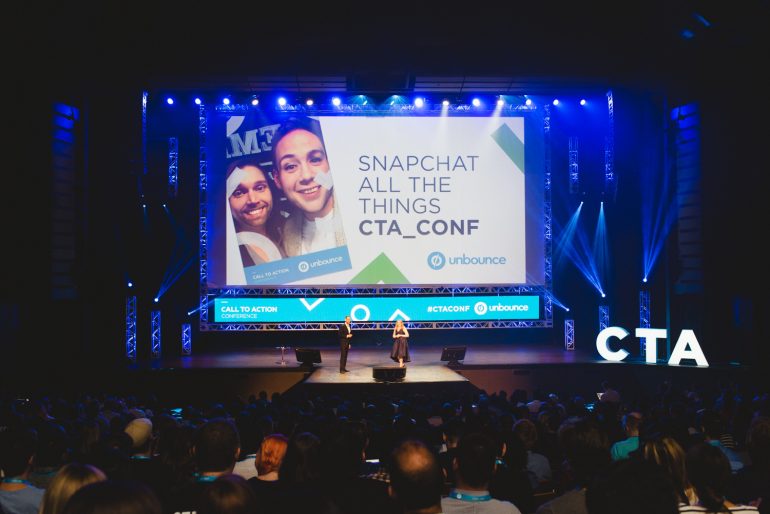If you’re not using data to find and reach out to customers, you’re operating blind. That was one of the core messages to about 1,000 attendees that came out for the Unbounce Call To Action (CTA) conference at the Queen Elizabeth Theatre in downtown Vancouver. The conference highlighted trends and innovations across industries. Throughout many of the speakers sessions, workshops, and special events, experts reaffirmed that content is king, storytellers are in more demand than ever, and increasingly, how you leverage data will determine whether your company (whether a tech startup or T-shirt store) is going to scale up, or even exist.
Here’s a taste of what some of the features speakers delivered at this high-energy event.
The age of the growth hacker
The co-founder of Unbounce, Oli Gardner, kicked off a keynote looking at how much data we can measure and use to convert customers.
We’re already looking past what the most insightful digital marketers can collate, analyze and inform about, to a point where machine learning tools will help companies understand what’s broken and how to optimize approaches to customers. Today’s tools make it much easier to do rapid experimentation, such as isolating images or copy, to see responses and tell if your customers actually understand what you’re offering. Is an image in a landing page helpful, or actually a distraction that’s preventing conversion? Instead of waiting weeks or months to adapt campaigns, today’s growth hackers, data scientists, and digital marketing experts are able to change things up on the fly.
Speaking with BetaKit after the presentation, he noted that “the most successful marketers now will be technical marketers, who understand the scientific method and testing, and maybe a little coding. Marketers were often looked down on by developers, but a lot of marketers today are technical.” He notes they’re emerging as the ‘growth hackers’ of this generation.
Plain text, please
“Email is the bomb,” began Susan Su, a partner at global VC seed fund and startup accelerator 500 Startups. “It’s the highest ROI channel. You don’t have to pay to play after you’ve got subscribers.” Yet email marketing just won’t work if people don’t open your messages – and decades after the first email was sent, even seasoned digital marketing professionals seem to not be using this basic tech tool in an effective way.
“Images are your enemy, including your logo and the CTA button – including even your background boxes,” she continued. “I’m not a designer, but I’ve fought with many – and those fights are always about images in emails. Images obliterate other elements that could be doing real selling above the fold.” She suggests sending a plain text email and see if it reads more or less like your HTML email. If it’s very different, you’ve got work to do.
The worst examples of bad digital marketing emails are often those that will get ignored in inboxes thanks to subject lines that don’t say anything meaningful. “Hot subject lines involve pattern disruption,” she adds – so it’s not just about saying something relevant, but saying it in a new way.
Track work, not just progress
It’s tempting for companies using the latest digital marketing toys to focus on the colourful line graph that shows a happy upward trajectory. Many companies do this at their peril, not adequately documenting the work that went into creating those results, so they can learn from it, said Rand Fishkin, the founder of Moz, a popular online marketing optimization tool.
He suggests that part of the problem is that digital marketers today think they already know what works: blog more, message more on social, grab email addresses from eBook downloads. “We think we know what matters and what doesn’t, so we don’t bother with manual link outreach, tweaking Facebook ads, or asking for Yelp reviews,” Fishkin said. “We assume the things we focus on will bring us success. But there’s no data about what went into the outcome report. We don’t know if we’re wrong, or what work going into moving the needle is effective.”
He likens this approach of also tracking inputs to that of using a Fitbit to track your progress on your daily walk – with those numbers available at a click, you can instantly see what you actually did to achieve good results (with 10,000 steps — or a marketing campaign). “We’ve got to know what works to create success.”
Getting video to work for you
“Very few companies are using video strategically,” said Kristen Craft, director of partnerships at Wistia, which handles video hosting for businesses. There are three basic rules for doing so: the video and the page that hosts it must work together; you need to identify clearly what you want to get out of your video; and your viewing metrics should inform your overall video strategy. Not many companies do all of these things well.
Part of the problem with thinking strategically is not knowing what’s a ‘typical’ result for different types of videos. That problem is heightened because “a lot of people think that play count is the be-all and end-all of metrics, but it’s a vanity metric,” she said. “Even if a million people watch, what business outcome has it driven?”
That said, she did provide some numbers for a crowd that might not have been satisfied with an ‘it depends’ kind of answer. Blog videos might get a few hundred plays typically (depending on the traffic your site normally gets). For ‘hero’ videos where you’re making a big video such as one highlighting a conference or a big promotion, with relatively high production value, you might see a few thousand plays.
There’s a new category of ‘sales video’ that Craft is seeing now that she’s excited about: short videos of roughly 20 seconds that are aimed at just getting a customer to buy from you, call you back, or just take that next step. It might be created solely for an audience of one person – but if that decision maker makes a move because of it, “you’ve won.” Videos like this can be very successful be delving into the one trait that makes most videos or marketing content effective: authenticity.
How good is ‘good’ when it comes to video marketing? Craft provided some rules of thumb: “Engagement rates of under 30 percent is bad. Over 60 percent is pretty good. Eighty percent or over is wizardry.”
Using tech to tell stories
For speakers and attendees alike, the core of the conference was around the increasing digitization, automation, and technical sophistication required for what many consider to be a creative part of the business process. One recalls the old cliché about companies before the Internet age knowing that half of their marketing was effective – “we just don’t know which half.” Today’s creative brand storytellers increasingly need to take on technical roles that were once the preserve of computer scientists and coders. Increasingly, marketers will find themselves not just hiring graphic designers and copywriters, but data analysts and engineers who can give them a technical edge. That’s what it’s going to take to keep customers from bouncing to a competitor’s site – and the best companies of the future will do that very well.



